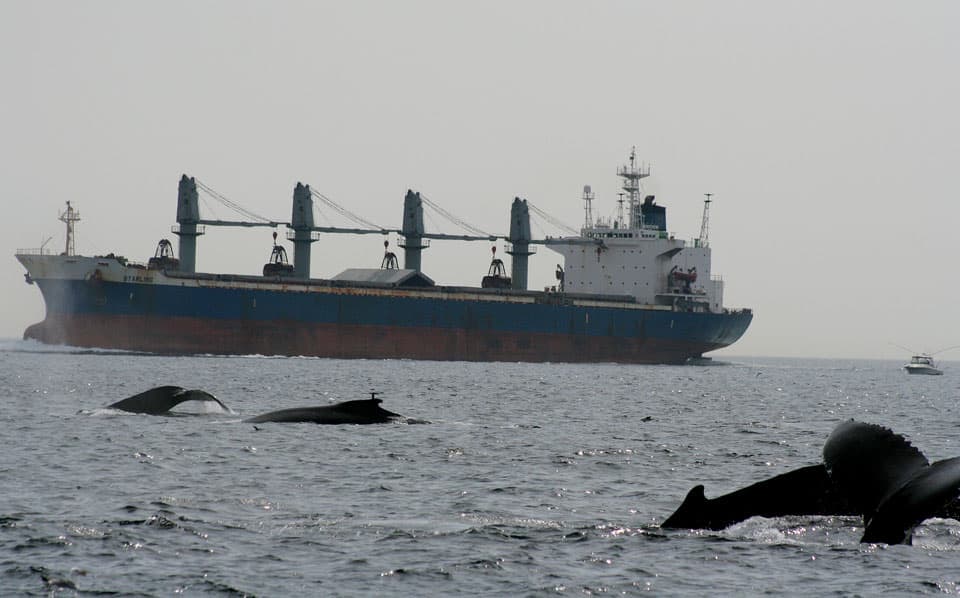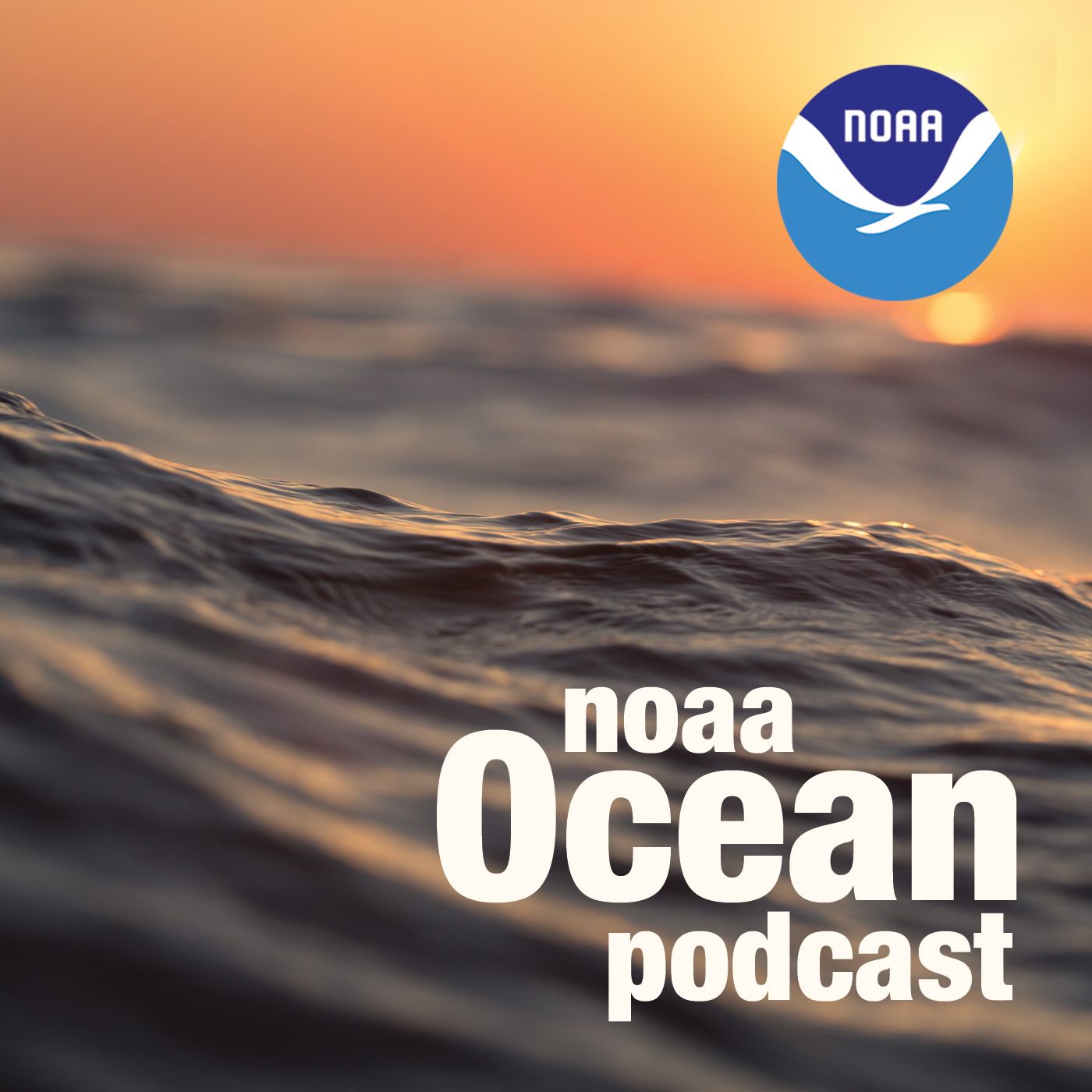Listen Up: What You Need to Know About Ocean Noise
NOAA Ocean Podcast: Episode 18
Many marine organisms, including marine mammals, sea turtles, fish and invertebrates, rely on sound and hearing for their survival. Over the last century, increases in human activity within our ocean have led to increasing levels of noise. This increasing amount of noise from human sources is a rising concern for the health and well-being of marine organisms and ecosystems. In this episode,NOAA marine ecologist Dr. Leila Hatch discusses her work to better understand the ocean soundscape by developing programs that can establish baselines, detect changes in noise levels, and support the design of methods to reduce noise impacts.

The level of noise pollution in the oceans has increased dramatically the last 50 years. As shipping traffic increases and ships get bigger and noisier, ocean noise is becoming a larger issue within NOAA's sanctuaries. Shown here: Whales surfacing near a tanker; photo taken under NOAA Fisheries Permit #981-1707-00.
Transcript
HOST: This is the NOAA Ocean Podcast. I'm Troy Kitch. In this episode, we're rebroadcasting a segment from a fascinating podcast we aired a few years ago about noise in the ocean. Let's listen in as host Megan Forbes talks to Leila Hatch, a marine ecologist based at Stellwagen Bank National Marine Sanctuary in Massachusetts. Leila's work focuses on acoustically-sensitive marine species and the effects of underwater noise in the sanctuary, and she provides support on noise science and policy for other sanctuary sites. She's also the co-lead of the NOAA Ocean Noise Strategy.
LEILA HATCH: Sound is an incredibly effective way for marine animals to communicate. A wide variety of marine animals make sounds to communicate to one another. And beyond using sounds to talk to one another, animals hear – and marine animals have particularly evolved to use their hearing in a great diversity of ways. They listen for food and the sounds made by their prey as it moves through the water, they listen to the echoes of environmental sounds – winds and waves – and the sounds they make against topographic features (underwater/undersea mountains) – which tells them about areas where fish may school, or where algae and zooplankton may cluster in upwelling. Those are all very predictable places for animals to find food, and they have an acoustic echo. They listen for their predators, and they listen to each other.
People also do a great many things offshore, and many of them make sound. Sometimes that sound is a bi-product of things that we are actually doing – we're moving all of the world's goods on large commercial ships, and that maritime traffic which is how we transport over 98% of the world's goods around the globe, we do that almost entirely on ships. Those ships have propellers, when they spin produce bubbles, and when the bubbles burst (they) make an acoustic signature – they make a sound. That sound has a deep, low frequency – those lower tones below what humans hear well – that low tone made by all those ships moving all that stuff around, its leading to a rise in noise level. People have used sound to communicate underwater between different ships, we also bounce sounds off of the crust of the earth to get a better understanding of what's below including oil and gas deposits. So we make sounds on purpose, and those sounds also can lead to a rising level of background noise. This combined, increasing level of human activity offshore, much of which makes sounds, has lead us to an understanding that the ocean's acoustic environments are quite different than they were when ocean animals evolved their systems to use the acoustics of their underwater environments.
Our job is to understand how that change in the acoustic quality of these places where animals live is affecting them. We're particularly concerned about their ability to hear one another at times that are very important in their life histories.
MEGAN FORBERS: Are we creating more noise now than ever?
LEILA HATCH: There are very few places in the world's oceans where we have been measuring in a standardized way how much noise there is in the ocean over time. But in the places where we have measured, such as off the central California coastline where we've been measuring since the 1940's and 50's, and we also can still make those same measurements in the same place today, the rise in the levels of background noise at very low frequency tracks very well with the growth of commercial shipping traffic and the quantity as well as size and gross tonnage of what we're carrying across that ocean basin. That trend is not as distinct in every place as we go to look around at the oceans, but again we don't have that timeline in such a calibrated and careful way in all of the places where we'd like to make those measurements. A lot of what we're doing now is trying to fill in an understanding of what today's background noise conditions look like as well as anything we might know about what they looked like historically.
MEGAN FORBES: Dr. Hatch has dedicated much of her life to this specific issue, and I was really interested in finding out why this particular issue was so important to her, personally.
LEILA HATCH: I grew up spending my time on a small farm and also offshore visiting my grandparents on an island. Those two environments exposed me to a lot of days both in the water and looking at tidal marine life, and listening and out in natural spaces in a rural environment. My father was a musician, and I think for that reason I spent a lot of time listening in those places. When I then met somebody who was a renowned researcher of whale calling behavior, those two things came together for me….an understanding that the world could be listened to, and the fact that huge animals in a marine environment that I didn't experience were calling to one another became fascinating to me. From the very beginning of studying whale vocalizations, I was exposed (to) and thinking about human effects on that behavior, and I've been very interested ever since in how we could change what we do in ways that would make more room for that animal experience to continue.
MEGAN FORBES: You are one of the leads of NOAA's Ocean Noise Strategy effort - tell us a bit about what it is, and what it's doing.
LEILA HATCH: NOAA's Ocean Noise Strategy grew out of an interest in ensuring that over the next decade we're better addressing the effects of noise on more than marine mammals…from noise effects that are more cumulative effects of many types of human activities, as well as the chronic effects of rising background noise conditions and the types of sources that contribute to those. A main focus of NOAA's Ocean Noise Strategy was to broaden the agency's approach to addressing noise impacts to not only account for those acute effects - those sudden effects on an individual marine mammal – but to better understand and to design tools to address the effects on acoustic habitat. Acoustic habitat simply means the acoustics of places. Places that are of importance to and sustain marine species that rely on listening. We call that the acoustic habitat of those creatures.
Want more? Check our show notes for the link to the full episode of this podcast. This is the NOAA Ocean podcast. Thanks for listening and head to iTunes to leave us a rating.

From corals to coastal science, connect with ocean experts to explore questions about the ocean environment.
Subscribe in iTunes | Subscribe to Syndicated Feed
Browse All Episodes of the NOAA Ocean podcast